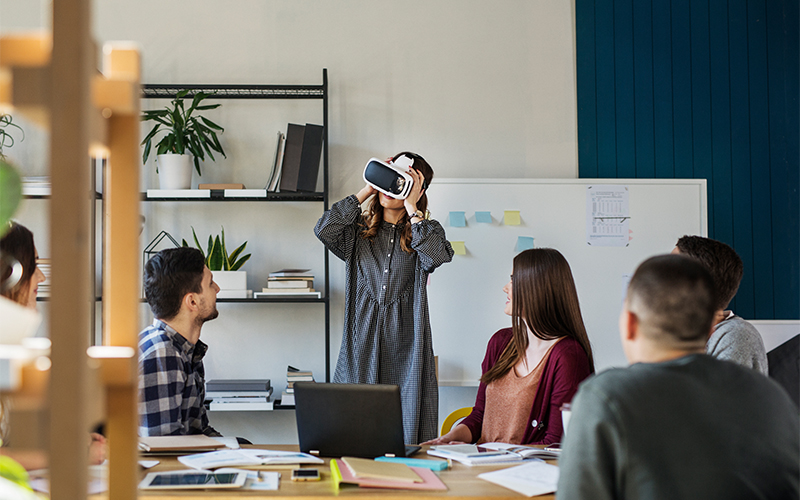Education Technology Services
Personalised learning technology tools for a tailored education
Education technology, or edutech, has paved the way for teachers to create and deliver advanced personalised learning for each student, irrespective of their location or ability. As schools are reopening worldwide, the hybrid learning model is here to stay and to ensure minimal disruptions to education in the future.*
Before the pandemic, only 1% of the students attended online schools and 10% took online courses. At the peak of the pandemic, 80% of the students were taking classes remotely. This provides flexibility to teachers and students in terms of knowledge sharing and experience within an inclusive space. Let us explore the types of technology-based learning methods and the benefits of personalised learning.
The benefits of personalised learning
Personalised learning has benefits for students and teachers alike, which include the following features:
- It allows students to learn at a pace comfortable for them. Some students can ace science subjects faster than history; others can perform better in English compared with mathematics. Moving at their own pace removes the barriers between students possessing different skill levels.
- Students can be proactive in their education. They intrinsically learn while choosing from the options laid out for them. When they have the freedom to choose their learning path and pace, they don't need that external push.
- Personalised learning provides opportunities for students to master technology simultaneously. While working on a computer, students learn to use MS Office, Google Docs, file-sharing software, videoconferencing software, edutech software, and more.
- A collaborative environment allows students to exchange ideas and thoughts with each other. While students choose their paths, their paths may overlap with other students. Contrary to the standardised format-based learning, personalised learning encourages collaboration and peer review.
- Personalised learning encourages students to move out of the standardised test format. One cannot assess the aptitude of all students based on a single test. While some students are good at solving problems, others could be good with presentations.
- Personalised learning prepares the students for a new and modern economy that does not have a one-size-fits-all model. Students have the freedom to assess their strengths and weaknesses while paving their unique paths.
Types of technology-based learning
Personalised learning technology tools enhance the teaching and learning experience for mutual growth. Edutech is evolving in several ways to augment personalised learning for students.
A video engages more senses than plain text or audio. A flipped classroom uses video to deliver instructions and optimises the time teachers and students spend together. If students watch the video before the class, teachers can ask relevant questions and explain more complex concepts. The new-age personalised learning technology tools make it easier to create videos that even the students can lead.
The present education system emphasises learning at a set pace and time, which widens the learning gap among students. The right edutech tools can help teachers adapt faster to the different learning paths students take and the standards set for them. For example, a learning management system in a school with mastery-based features allows teachers to show or hide certain content based on a student's previous activities and results.
An adaptive learning system learns about the students as they progress and adapts to feedback and suggestions at every step. It tailors the next steps based on how the students performed in the previous ones. The teacher can define these rules that either takes the students to the remaining questions or reveals further learning resources. Adaptive learning is a truly personalised method for both regular and special needs children.
Virtual reality and augmented reality combined with 360-degree media and 3D simulations create an immersive experience for the students. These technologies provide a high degree of interactivity irrespective of the students’ age.
How can Infosys BPM help?
The paradigm shift in the education sector is a marker of how technology will impact our futures. While the change is in its early stages, we must innovate and make education inclusive and individualistic. Infosys BPM offers edutech solutions that help you take on the challenge of personalised learning. Our comprehensive suite of services can ease the shift to a hybrid learning model for all stakeholders, including teachers, students, parents, and school administrators.
*For organisations on the digital transformation journey, agility is key in responding to a rapidly changing technology and business landscape. Now more than ever, it is crucial to deliver and exceed organisational expectations with a robust digital mindset backed by innovation. Enabling businesses to sense, learn, respond, and evolve like living organisms will be imperative for business excellence. A comprehensive yet modular suite of services is doing precisely that. Equipping organisations with intuitive decision-making automatically at scale, actionable insights based on real-time solutions, anytime/anywhere experience, and in-depth data visibility across functions leading to hyper-productivity, Live Enterprise is building connected organisations that are innovating collaboratively for the future.






